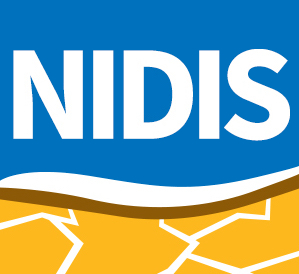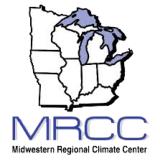Drought Improves Across Midwest, But Long-Term Precipitation Deficits Remain Going into Summer
Key Points
- Drought conditions generally improved across the Midwest over the last month, with only 11% of the region in Moderate to Severe Drought (D1-D2) according to the U.S. Drought Monitor. Much of the remaining drought is in western portions of the region, with a small pocket of D1-D2 in east-central Michigan.
- Drought conditions improved in the short term, and in many areas, current impacts at the surface are minimal. However, long-term precipitation deficits remain an issue across Iowa, portions of northern Missouri, and the southern third of Minnesota, with deficits of at least 20 inches over the last four years. Some isolated areas have deficits of over 40 inches.
- In Iowa, Missouri, and Minnesota, underlying dryness means these areas will rely on regular spring and summer precipitation to avoid worsening drought conditions. If unseasonably warm and dry conditions develop, the long-term precipitation deficits increase the risk for the rapid expansion and intensification of drought.
- The seasonal outlooks for May–July 2025 show potential for far western portions of Minnesota and Iowa to receive below-normal precipitation, with equal chances for above-, near-, or below-normal precipitation elsewhere. As a result of this outlook, drought is expected to persist or redevelop through the end of July across Iowa, Minnesota, and Missouri, with potential expansion in far western areas.
- Potential impacts if drought persists or develops include inadequate moisture for the growing season, elevated risk for wildfire, and hydrological issues, particularly in areas that have longer-term precipitation deficits in Iowa, Missouri, and Minnesota.
This update is based on data available as of Thursday, April 24, 2025 at 8 a.m. CT. We acknowledge that conditions are evolving.
The U.S. Drought Monitor depicts the location and intensity of drought across the country. The map uses 5 classifications: Abnormally Dry (D0), showing areas that may be going into or are coming out of drought, and four levels of drought (D1–D4).
The U.S. Drought Monitor is a joint effort of the National Oceanic and Atmospheric Administration, U.S. Department of Agriculture, and National Drought Mitigation Center.
A drought index combines multiple drought indicators (e.g., precipitation, temperature, soil moisture) to depict drought conditions. For some products, like the U.S. Drought Monitor, authors combine their analysis of drought indicators with input from local observers. Other drought indices, like the Standardized Precipitation Index (SPI), use an objective calculation to describe the severity, location, timing, and/or duration of drought.
Learn MorePeriods of drought can lead to inadequate water supply, threatening the health, safety, and welfare of communities. Streamflow, groundwater, reservoir, and snowpack data are key to monitoring and forecasting water supply.
Learn MoreDrought can reduce the water availability and water quality necessary for productive farms, ranches, and grazing lands, resulting in significant negative direct and indirect economic impacts to the agricultural sector. Monitoring agricultural drought typically focuses on examining levels of precipitation, evaporative demand, soil moisture, and surface/groundwater quantity and quality.
Learn MoreU.S. Drought Monitor Categories
D0 - Abnormally Dry
Abnormally Dry (D0) indicates a region that is going into or coming out of drought. View typical impacts by state.
D1 - Moderate Drought
Moderate Drought (D1) is the first of four drought categories (D1–D4), according to the U.S. Drought Monitor. View typical impacts by state.
D2 - Severe Drought
Severe Drought (D2) is the second of four drought categories (D1–D4), according to the U.S. Drought Monitor. View typical impacts by state.
D3 - Extreme Drought
Extreme Drought (D3) is the third of four drought categories (D1–D4), according to the U.S. Drought Monitor. View typical impacts by state.
D4 - Exceptional Drought
Exceptional Drought (D4) is the most intense drought category, according to the U.S. Drought Monitor. View typical impacts by state.
Total Area in Drought (D1–D4)
Percent area of the Midwest that is currently in drought (D1–D4), according to the U.S. Drought Monitor.
The U.S. Drought Monitor depicts the location and intensity of drought across the country. The map uses 5 classifications: Abnormally Dry (D0), showing areas that may be going into or are coming out of drought, and four levels of drought (D1–D4).
The U.S. Drought Monitor is a joint effort of the National Oceanic and Atmospheric Administration, U.S. Department of Agriculture, and National Drought Mitigation Center.
The U.S. Drought Monitor is released every Thursday morning, with data valid through the previous Tuesday at 7 a.m. ET.
A drought index combines multiple drought indicators (e.g., precipitation, temperature, soil moisture) to depict drought conditions. For some products, like the U.S. Drought Monitor, authors combine their analysis of drought indicators with input from local observers. Other drought indices, like the Standardized Precipitation Index (SPI), use an objective calculation to describe the severity, location, timing, and/or duration of drought.
Learn MorePeriods of drought can lead to inadequate water supply, threatening the health, safety, and welfare of communities. Streamflow, groundwater, reservoir, and snowpack data are key to monitoring and forecasting water supply.
Learn MoreDrought can reduce the water availability and water quality necessary for productive farms, ranches, and grazing lands, resulting in significant negative direct and indirect economic impacts to the agricultural sector. Monitoring agricultural drought typically focuses on examining levels of precipitation, evaporative demand, soil moisture, and surface/groundwater quantity and quality.
Learn MoreCurrent Conditions and Impacts for the Midwest
- Drought conditions generally improved over the last month, with only 11% of the Midwest in Moderate to Severe Drought (D1-D2), according to the U.S. Drought Monitor. This is 32% less area in drought than early March.
- 46% of Minnesota is in drought, with Severe Drought (D2) in northern Minnesota. Drought conditions are contributing to below-normal water levels at the headwaters of the Mississippi River. Michigan has a small pocket of Moderate to Severe Drought (D1-D2) in the Saginaw Valley in east-central Michigan.
- Precipitation was near- to above-normal for much of the Midwest since March 1, particularly in the Ohio River Basin, where there was a historic rainfall and flooding event in early April.
- Streamflow and soil moisture remain below normal in some areas, including portions of Iowa, Minnesota, northern Illinois, and Lower Michigan.
- A lack of snow this winter and windy conditions led to an increased number of wildfires in Wisconsin. As of April 23, the state already had more than 550 fires this year, which is double the average. More than 2,000 acres have burned, which has already surpassed the annual average.
- Despite recent rainfall, long-term precipitation deficits remain an issue across Iowa, portions of northern Missouri, and the southern third of Minnesota, with deficits of at least 20 inches accumulated over the last four years. Some isolated areas have deficits of over 40 inches.
- Lake Michigan’s level was below the long-term average for this time of year due to a dry fall and ongoing evaporation.
Drought Improved Across Majority of Midwest
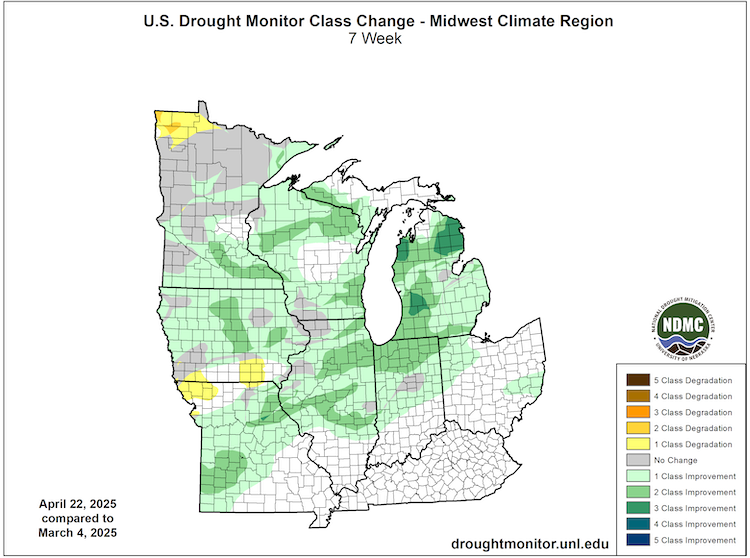
Near- to Above-Normal Precipitation Since March 1

Longer-Term Precipitation Deficits Increase Flash Drought Risk
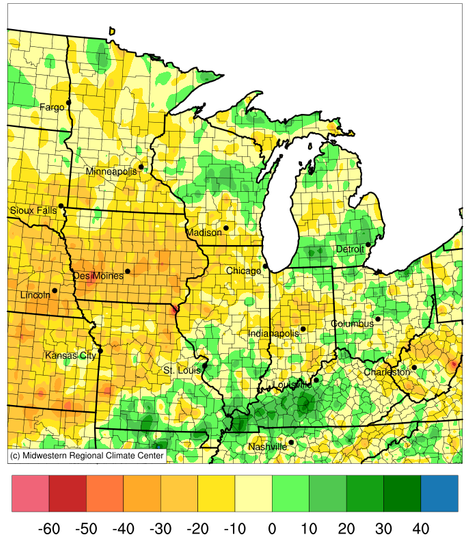
Outlooks and Potential Impacts in the Midwest
- Outlooks for May 2025 call for a slight chance of above-normal precipitation across the Ohio River Basin, including Kentucky, Ohio, Indiana, southern Illinois, and southeast Missouri. Below-normal precipitation is expected in a small portion of northwest Minnesota. Elsewhere, there are equal chances for above-, near-, or below-normal precipitation.
- The three-month outlook for May 1–July 31 shows increased chances for above-normal temperatures across the majority of the Midwest, with the exception of northwest portions. The three-month outlook for precipitation forecasts equal chances for above-, near-, or below-normal precipitation across much of the Midwest. However, far western portions of Minnesota and Iowa are favored to receive slightly below-normal precipitation.
- As a result of this outlook, drought is expected to persist or redevelop through the end of July across Iowa, Minnesota, and Missouri, with potential expansion in far western areas.
- As mentioned previously, portions of Iowa, Missouri, and southern Minnesota have longer-term precipitation deficits between 20 to 50 inches, which means these areas will be very reliant on regular spring and summer precipitation to avoid worsening drought conditions. If unseasonably warm and dry conditions develop, the long-term deficits increase the risk for the rapid expansion and intensification of drought.
- If drought persists or develops, potential impacts include inadequate moisture for the growing season, elevated risk for wildfire, and hydrological issues (e.g., low streamflow and groundwater, water supply issues).
Odds Favor Above-Normal Precipitation over Ohio Basin in May
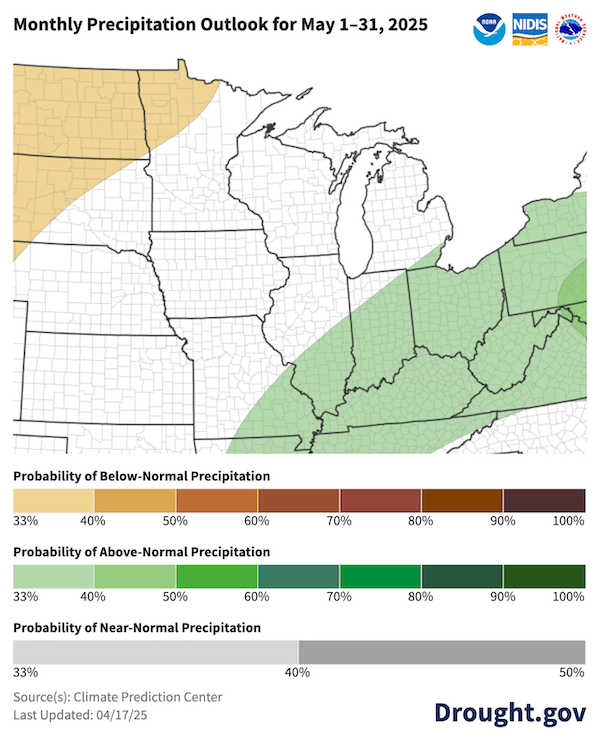
Drought Development Favored by Late July in Western Portions of the Midwest
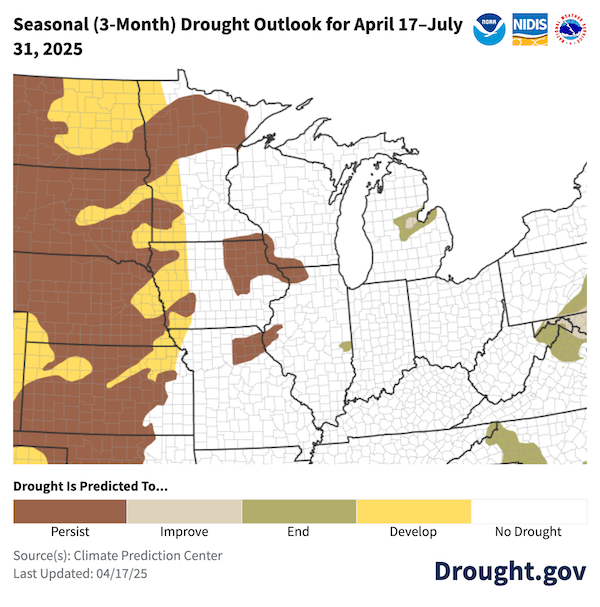
Resources
- More local information is available from the following resources:
- To report or view local drought impact information:
Prepared By
Molly Woloszyn
Cooperative Institute for Research in Environmental Sciences (CIRES) / NOAA National Integrated Drought Information System (NIDIS)
Dennis Todey
U.S. Department of Agriculture Midwest Climate Hub
Doug Kluck
NOAA National Centers for Environmental Information
Jeff Boyne & Andrea Thielke
NOAA National Weather Service Central Region
Jim Noel & Molly Peters
NOAA National Weather Service Ohio and North Central River Forecast Centers
Anna Wolverton
U.S. Army Corps of Engineers Mississippi Valley Division / NOAA National Weather Service
Melissa Widhalm
Midwestern Regional Climate Center / Purdue University
Denise Gutzmer
National Drought Mitigation Center
A special thank you to the state climate offices and National Weather Service offices in the Midwest region for providing local information on drought conditions and impacts included in the North Central webinar and in this Drought Status Update.
This Drought Status Update is issued in partnership between the National Oceanic and Atmospheric Administration (NOAA), U.S. Department of Agriculture (USDA), U.S. Army Corps of Engineers (USACE), and the National Drought Mitigation Center to communicate a potential area of concern for drought expansion and/or development within the Midwest region based on recent conditions and the upcoming forecast. NIDIS and its partners will issue future Drought Status Updates as conditions evolve.

